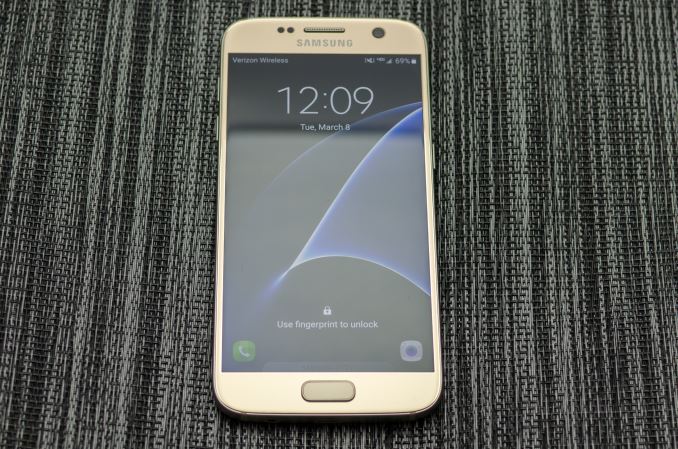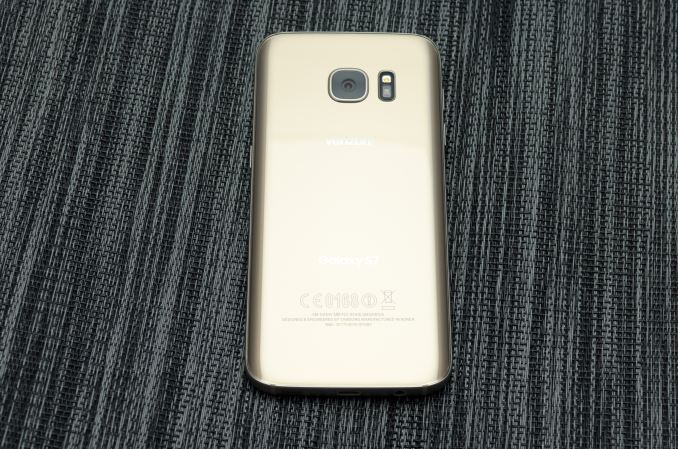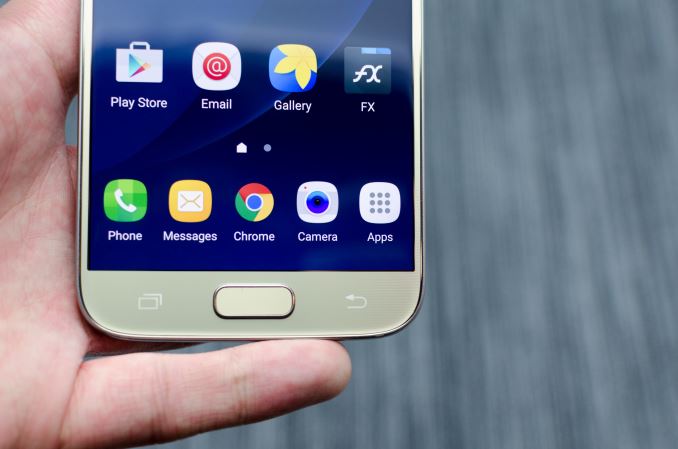The Samsung Galaxy S7 & S7 Edge Review, Part 1
by Joshua Ho on March 8, 2016 9:00 AM ESTInitial Conclusions
Even though we’re just barely scratching the surface of what we can test, the results we already have show quite a bit about the Samsung Galaxy S7. The Galaxy S line remains one of the most popular Android smartphones, and if history is any indication we can get a pretty good idea about what to expect for 2016 just by looking at the Galaxy S7 and S7 edge.
The first place we can start is design, and here we can see that the Galaxy S7 is decidedly an evolution of the Galaxy S6’s ID. However, pretty much every sharp edge has been rounded out to make the device more comfortable in the hand. The device has also been thickened in order to handle the larger battery and reduce the apparent z-height of the camera. The display size of the Galaxy S7 (non-edge) stays at 5.1 inches, and given how long Samsung has stuck to this display size it’s likely that they will be staying at this size for quite some time for their flagship.
In general, it feels like the industry has settled upon a display size somewhere between 5 to 5.5 inches for their flagship devices as going further probably won’t make a lot of sense for ergonomic reasons. I suspect Samsung and many other Android OEMs are settling into an Apple-like 2 year cadence for industrial and material design as replacement cycles lengthen, especially in the United States where subsidized phones have been almost entirely eliminated.
Meanwhile, though we haven’t had the time to run our full suite of battery life benchmarks, the data that we do have is quite interesting. At the very least, it looks like the Galaxy S7 will be a solid upgrade for those coming from the Galaxy S6 and earlier with a 15% bump in battery life or so. Anyone using a phone with an SoC not on a FinFET node will see even bigger gains to battery life, which is impressive to say the least. If you have any device with a Snapdragon 810 or 808 SoC, you’re definitely going to see major gains if you move to any device with a SoC fabricated on a FinFET node.
In terms of SoC performance, the Snapdragon 820 doesn't disappoint. In the time since testing the MDP it seems that between Qualcomm, Samsung, and Google, the trio has finally been able to optimize Snapdragon 820 for Chrome, so performance there is quite acceptable now and a pretty solid uplift over something like the Exynos 7420 or Snapdragon 810. GPU performance is also pretty much right where the Snapdragon 820 MDP was, so performance should be a good step above the A9's GT7600 GPU. Of course, we have yet to consider the power efficiency or sustainability of this performance, but turbo/overdrive performance is always relevant in the mobile space considering just how bursty almost every mobile workload is. It's pretty safe to say that Qualcomm has at least regained their footing in the SoC space, and with future SoCs they may well come to dominate the high end for performance and power once again. For now, it's looking like the race between Exynos 8890, Snapdragon 820, and Kirin 950 will be quite close.
For storage performance, to some extent it seems that the performance gains are relatively small, as the UFS 2.0 storage solutions on the Galaxy S6 and S7 are relatively similar. It’s interesting to see here that despite the now-mandatory use of FDE, the delta in performance between the Galaxy S6 and S7 in storage performance doesn’t seem to exist. This is welcome news as it wasn’t all that long ago that FDE for Android had a noticeable effect on storage performance.
On the display side, again we can see that the Galaxy S7 has a relatively similar display to the Galaxy S6. Calibration should be relatively good across the board, and AMOLED retains all of its traditional advantages including high contrast, support for wide color gamuts, low transition time, and improved power efficiency at lower average picture levels. Peak brightness is the only noticeable area where things seem to change, but I suspect that this will vary noticeably depending upon the unit. The one issue that I continue to notice here is that the edge display on the Galaxy S7 edge has a green tint at the edges, likely due to the diamond PenTile subpixel arrangement.
On the software side, Samsung’s TouchWiz UI continues to be more of the same when compared to the Galaxy Note5. The edge features continue to be somewhat interesting, but I continue to find myself thinking that there would be no difference if the same feature was implemented on the non-edge variant. Thankfully, the lag that I noticed last month in my initial hands-on time with the device seems to just have been a function of pre-release software, as the Galaxy S7 is relatively performant here. Although I’m not sure I’d go as far as to say that the Galaxy S7 is entirely free of lag. I suspect that Samsung has to balance power efficiency and responsiveness to some extent here, as while devices like the Nexus 5 can feel incredibly smooth and responsive there are very real knock-on effects in terms of practical battery life.
I’m also looking forward to testing features like Samsung Pay that are finally being deployed to the extent that I can use my personal credit card with Samsung Pay on my phone. However, out of the box TouchWiz still has some issues with an overly-neon theme, and in general things like Always-On Display already feel like they aren’t quite executed as well as they should be. I also noticed that the fingerprint scanner performance is strongly influenced by initial setup if I didn’t scan some areas on initial setup they never seemed to work very well unless I retrained the finger.
As for making a choice between the Galaxy S7 edge and Galaxy S7, there basically aren't any outside of size for the most part. There is the edge display, but by and large it feels like that's more of an aesthetic choice than a functional one. As we have seen you do get better battery life in the Galaxy S7 edge, but I don't feel like it makes sense to cross-shop the two. If you want one-handed usability, the Galaxy S7 is the only choice that makes sense. If you want a phablet, the Galaxy S7 edge is the only choice that makes sense.
Overall, I think the Galaxy S7 is looking to be one of the better devices of the year. Of course, there’s still a lot more to test, but the initial indications are already looking quite good. If you absolutely want the Galaxy S7 now, I don’t think there will be any major showstoppers present in this phone. However, if you’re looking to buy the best phone possible available this year I think it’s still too early to say where the chips will fall as Samsung's eager competitors have their own flagship phones right around the corner.














202 Comments
View All Comments
Belard - Friday, March 11, 2016 - link
What I find shockingly stupid is the release of these new $600~900 phones, including the latest Moto X, that DO NOT include USB-C connector?! Its been available since last year.Apple does things quickly, they come out with technology and release it: such as with the iPhone 5 with its reversible port. How hard is it to do with other companies?
Motorola (Lenovo) could have done this with their New X to make a bold statement on how they are going to run their business.
theduckofdeath - Friday, March 11, 2016 - link
Probably because Samsung has usage data on what we actually use the USB port for these days. And I guess it's used almost exclusively as a charger. Why force the consumers to buy a bunch of new cables and chargers just because there is a new port out there? I know Apple would do that in a heartbeat, like you said, as they simply see it as a new way to increase earnings on licensing accessories.Azurael - Tuesday, March 15, 2016 - link
Because USB-C is much easier and quicker to connect? (I certainly find the 5X and 6P much easier to connect in a darkened room - good thing since Google nicked Qi charging.)Because USB-C cables and sockets should be (probably too early to say, but by design) far less prone to failure than Micro-B? (Micro-B cables, and not cheap ones - OEM LG/Nokia/Sony/Moto cables, die on me on a weekly basis. About half of the cables I own only work for charging now.)
I don't know, why don't we still connect our keyboards with the AT connector or PS/2, and our digital video cameras by firewire?
You don't need new chargers. If you've got dozens of USB-A power supplies, just use an A-C cable.
theduckofdeath - Tuesday, March 15, 2016 - link
I'm not suffering from long connection times when connecting my mobile to the charger. Sure, it would be nice with a more uniform connector, but, if it comes at the expense me having to throw away all old cables, having to bring adapters and generally making life more expensive, I can easily live with a micro USB connector until connectors are entirely a thing of the past.Physical connectors for data transfer is really not essential these days. These phones has wifi and LTE connectivity at speeds close enough to any USB connection to make us not bothering transferring anything by wire any more.
Belard - Tuesday, March 15, 2016 - link
Uh, just need to replace the cable or it comes with the phone... not difficult. A flip-able cable is VERY handy, especially in the dark. Unless the end is marked or molded a different shape - you have to LOOK which side is up. Apple changed the cable ONE time, because they wanted a much smaller and better connector.So for a top end phone, I want a state of the art connector too. hence, I bought a new Moto G for $220... I lose the stereo speakers, but I saved $200 and have two free color covers I switch out for when I'm in the mood. So maybe I'll stick with the Gs.
Bruce Dunn - Friday, March 11, 2016 - link
For the average cell phone buyer, most of the information in this review goes right over their heads. I hope that part 2 of the review will address in simple language the following:Can I read the display in direct sunlight (giving me the number of nits emitted by the display does not tell me this).
What happens if I drop the phone into a sink full of water.
What happens if I drop the phone onto a concrete floor.
peedroo - Saturday, March 12, 2016 - link
http://www.displaymate.com/Galaxy_S7_ShootOut_1.ht...Maximum screen brightness in high ambient light results
s.yu - Thursday, March 17, 2016 - link
Anandtech is not for the "average cell phone buyer". It's for people who *really want to know*. If there were more of us there would be less rip-off products on the market and everything would be easier, more money would be devoted to R&D instead of marketing and more will be achieved.peedroo - Saturday, March 12, 2016 - link
Loved the review till nowBut here
http://www.displaymate.com/Galaxy_S7_ShootOut_1.ht...
...they have tottaly diferent results about screen brightness levels when we compair it to the S6. It's better
karthik.hegde - Sunday, March 13, 2016 - link
I think what article needs to highlight more is that the Kirin 950 handily beats SD820 is most of the tests. ARM Cortex-A72 is a great core, released quite sometime ago still doing pretty well. I am sure ARM has new CPUs in the pipeline which will be released soon.I wonder if it makes sense for Qualcomm from business perspective to continue designing their own cores, while ARM already offers stock cores with great performance.